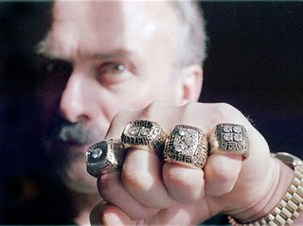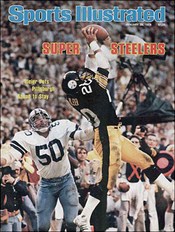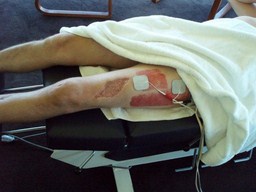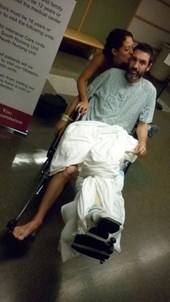Mind Over Matter: A Modern-Day Rocky Bleier Story
by Dr. Nicolas Campos
 The Pittsburg Steelers of the 1970s had many greats of the National Football League (NFL). Who could forget players like Terry Bradshaw, Franco Harris, Jack Lambert and Mean Joe Greene? But the Steelers player that has touched me the most is Rocky Bleier. With the tenacity of a bulldog, and the mental toughness to match, Rocky Bleier overcame great odds to not only continue to live the life he loved, but to also become a champion.I am so inspired by Rocky Bleier’s story that I often tell it to my patients. It illustrates exactly what it takes to overcome great adversity, whether talking of a physical injury, or any other challenging life experience. His story shows the magnificent power of the mind and body, and how by syncing the two, you can achieve great strides in your health, and your life. The Pittsburg Steelers of the 1970s had many greats of the National Football League (NFL). Who could forget players like Terry Bradshaw, Franco Harris, Jack Lambert and Mean Joe Greene? But the Steelers player that has touched me the most is Rocky Bleier. With the tenacity of a bulldog, and the mental toughness to match, Rocky Bleier overcame great odds to not only continue to live the life he loved, but to also become a champion.I am so inspired by Rocky Bleier’s story that I often tell it to my patients. It illustrates exactly what it takes to overcome great adversity, whether talking of a physical injury, or any other challenging life experience. His story shows the magnificent power of the mind and body, and how by syncing the two, you can achieve great strides in your health, and your life.
I will share the Rocky Bleier story with you here, as well as that of a modern-day Rocky Bleier—a spirited and determined man with whom I have had the honor and privilege of working. Following a serious motorcycle accident that had left him “mangled,” my client and I worked determinedly to return him to health and normal functioning. I hope that his story inspires you as it has me—like the Rocky Bleier story, it shows what can be accomplished with a focused intention, a solid belief and a big heart. Fighting Back
During the war, Bleier was shot in the left thigh, and while down, he was hit by a grenade that sent shrapnel into his right leg. Rocky was told he would never play football again; in fact, he would be lucky if he could ever walk. But Rocky Bleier, being a natural fighter, was determined to walk, and he was even more determined that he would play ball again. By using the strength of his mind and will, he worked hard to rehab his legs, and he regained his ability to walk. He returned to the Steelers in 1969. That first year back, Bleier came in at only 180 pounds, but worse, he could barely walk. For the next two years he worked hard to regain a position on the team, but his recovery was slower than he wanted, and he eventually got cut from the team…twice. But again, his mind didn’t falter. He spent several more years pounding the rehab and training pavement, and in 1974 he remade the team, weighing in at a solid 212 pounds. Football fans will recall that Rocky Bleier not only made the team, he was an integral part of four Super Bowl championships. He even made the winning catch inSuper Bowl XIII. I don’t know about you, but I find Rocky Bleier’s story so inspiring! Maybe it’s because I work with people suffering from various musculoskeletal and sports injuries, and I see firsthand how hard it is for many to recover. And not because they can’t, mind you—which is the point of this story—but because the mind is the most powerful player in the healing game, and for many, it works against their complete recovery. I find that if the mind is not completely aligned with the desire, belief and certainty of a complete recovery, as well as being prepared for the rigors that will accompany it, then achieving it will be highly unlikely. Modern-day Rocky
Taken by ambulance to nearby Cedars Sinai Medical Center, Mr. Robb was rushed into emergency surgery to save his leg. He had fractured his left femur, tibia and fibula, while incurring several open wounds to his left leg. He was told by staff at the hospital that his leg when he came in the night before had been “mangled.” I would have to say that, judging by Initial AssesmentFortunately, Mr. Robb has had the best doctors on his team. From the orthopedists that restored his leg, to the emergency room and general staff at Cedars Sinai, to the plastic surgeons that worked their reconstructive magic, he had a solid squad that pretty much repaired the structural damage, but the time had come for neuromuscular re-education. Mr. Robb presented to my office walking on crutches Pain and Disability Can Be a Mind GameIt has been said that pain is all in the mind. In some ways that might be obvious, considering our pain processing centers reside in the parieto-insular cortex of the brain. But studies now show that chronic pain can actually make physical changes to the brain itself, leading to further processing dysfunction, and thus further pain. These findings suggest that the brain plays a major role in the development and treatment of pain syndromes. The key, then, in any rehab protocol is to decrease pain as soon as possible. The longer pain hangs around, the less likely it will resolve at all. But the good news is that pain and functionality run together—so, often, as one improves so does the other. Under many circumstances, function is the most important factor in the rehabilitation process, but in some cases (and I have reason to speculate that the degree of injury is a major component here) pain needs to be address first. Mr. Robb was prescribed pain medication, as are all people involved in motor vehicle accidents, to help him get His decision, I knew, would have significant benefits to the rehab program, mostly in his being fully present throughout treatment, as well as during his home care, but also in re-establishing the vital connections between his sensory nervous system and the joints, muscles and tendons of the limb. Also the potential cognitive and spiritual advantagesmade this an attractive approach, as the right mind can connect to a greater power and higher brain function to help the healing process along. My approach was to start with simple movements, both passive and active, lightmyofascial release (similar to massage), and chiropractic adjustments. Once the initial pain and disability were to be overcome, we could then move into proprioceptive work, and finally into stretches and weight-bearing exercises. Rehabilitation of Severe MVA Injuries
Round 1:
We carried out the above regimen three times per week for two weeks. Toward the end of this first round, Mr. Robb was examined by his plastic and orthopedic surgeons, both of whom reported excellent progress. My hope with this article is to document and share an effective rehabilitation protocol for the most drastic of neuromusculoskeletal injuries. The rationale behind this program is appropriate for most major traumatic and surgical recoveries, although region-specific changes might need to be considered. Saying that, our approach was universal in that we strove to reestablish neurological connections to the limbs first and foremost, while also paying attention to proper nutrition and primary sensory stimuli, before moving onto tissue lengthening, and ultimately, motor movements and control. Next month, I will continue where I left off and discuss Rounds 2 and 3 of Mr. Robb’s rehabilitation program. You will see how we slowly transitioned into each new phase, conducting a balanced dance between repetitive conditioning (learning) and constant, yet ever changing, challenge. Rocky Bleier would be proud. Novermber 3, 2011 |

 Rocky Bleier was a standout half-back for the
Rocky Bleier was a standout half-back for the 

 what I saw the first day he came hobbling into my office some six weeks after the accident, mangled was a good description. With massive wounds to his shin, calf and thigh, which looked as if chunks of flesh had been shorn from the bone, his doctors had described to him the protrusion of bone fragments that pierced his skin, and how they had worked for hours inserting metal rods into his three broken leg bones that fateful night.
what I saw the first day he came hobbling into my office some six weeks after the accident, mangled was a good description. With massive wounds to his shin, calf and thigh, which looked as if chunks of flesh had been shorn from the bone, his doctors had described to him the protrusion of bone fragments that pierced his skin, and how they had worked for hours inserting metal rods into his three broken leg bones that fateful night. and equipped with a foot boot. The purpose of the boot was primarily to prevent the
and equipped with a foot boot. The purpose of the boot was primarily to prevent the  through the inevitable pain he would likely experience over the next few weeks. He made it very clear at the beginning of our sessions that he wanted to be as medication-free as possible; he had little interest in dealing with the
through the inevitable pain he would likely experience over the next few weeks. He made it very clear at the beginning of our sessions that he wanted to be as medication-free as possible; he had little interest in dealing with the The following is a list of treatment protocols and the rationale behind them, as well as the chronology with which they were introduced into the rehabilitation for Mr. Robb. I will also include the progress both subjectively and objectively as we witnessed it. At the time of this writing, we are still working, as we finish up the eleventh week of rehab.
The following is a list of treatment protocols and the rationale behind them, as well as the chronology with which they were introduced into the rehabilitation for Mr. Robb. I will also include the progress both subjectively and objectively as we witnessed it. At the time of this writing, we are still working, as we finish up the eleventh week of rehab.